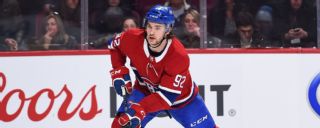Typically, you want to roster players who score on the power play, especially if your league counts PPP as a category. But drafting players who are overly reliant on power play can be dangerous for your roster. If a player taken later in the draft achieves a high percentage of his points from the man advantage, his fantasy value could disappear if he loses his power-play spot or if the unit disappoints.
I looked at late-round players who have scored a high percentage of their points on the power play over the past three seasons and identified a handful who might be in line for a dip in production this season due to either a lost opportunity or a lackluster man-advantage unit.
Here are five players to avoid in drafts due to a high dependence on a shaky or nonexistent power-play role. We also included the top-50 power-play dependent players over the past three seasons for your reference.
Note: Power-play point percentages are over the past three seasons, with the exception of Jonathan Drouin (past two seasons).

Jonathan Drouin, C/LW, Montreal Canadiens
Power-play point percentage: 48.5
For all of the problems in Montreal last season, the power play was actually pretty good, scoring at a 21.2 percent clip. Drouin's utility playing both in front of the net and outside led to four goals and 16 assists on the man advantage. Over his two full seasons with the Canadiens, Drouin has been super dependent on the power play for fantasy value, logging 48.5 percent of his points there.
Despite the Habs' power-play success, there were underlying reasons for concern, specifically low shooting percentages. Having dealt Alex Galchenyuk and Max Pacioretty, and with Shea Weber out until December at the earliest, the Canadiens lose much of their power-play talent this season. Drouin's power-play assists will depend on someone else stepping up to replace the two departed forwards. Look to see where the 23-year-old lines up (it could be the point, alongside Jeff Petry) and who joins him on the unit, but downgrade him accordingly, as this power play won't be the same.

Justin Faulk, D, Carolina Hurricanes
Power-play point percentage: 48.0
Faulk, currently going in the 22nd round, is reliant on power-play assists for fantasy relevance. And he has delivered value relative to his position during the past few seasons, notching 16 assists and scoring 48 percent of his points with the advantage. Faulk led the Hurricanes' top power-play unit, but the team added serious depth to its defense, signing Calvin de Haan and trading for Dougie Hamilton. Faulk, who scored 12 power-play goals just three seasons ago, can deliver from the bottom of your lineup if the time is there, but he will lose that No. 1 power-play role and could see his overall time decrease with the Canes' defensive depth.

Jake Muzzin, D, Los Angeles Kings
Power-play point percentage: 35.3
Muzzin has scored 35 percent of his assists (and 35.3 percent of his points) on the power play over the past three seasons, but that looks to fall because of one big acquisition. Ilya Kovalchuk was one of the best in the business operating from the left point on the power play before he bolted the NHL for the KHL, and that has been Muzzin's spot with the Kings' man advantage. In his previous NHL stint, Kovalchuk dominated power-play minutes for the New Jersey Devils, and he has looked fantastic this preseason. Muzzin will still be a productive defenseman for the Kings, but without those PP points, he might not have much fantasy value.

Anders Lee, C/LW, New York Islanders
Power-play point percentage: 33.1
Well, you know the Islanders are going to take a hit with the loss of John Tavares. Lee, who played on the top power play unit alongside Tavares and Mathew Barzal, had a breakout year with 40 goals, fueled by 14 of them on the man advantage. Lee and Tavares were front-of-the-net presences for the Islanders, and Lee benefited from the attention Tavares drew. With the latter now in Toronto, Lee will see more shots, but also more defensive attention. The Islanders as a team should suffer from regression, as their 23.2 percent power-play rate was significantly higher than their averages over the past four seasons -- and now their best player is gone.

Artem Anisimov, C, Chicago Blackhawks
Power-play point percentage: 25.6
Anisimov was the definition of a one-category asset, scoring 11 of his 20 goals on the power play while playing with Patrick Kane. Unfortunately, that Blackhawks power play appears to be headed for regression.
The Blackhawks drew the second-most power play time in the NHL, uncharacteristic for a team that is generally middle-of-the-pack in drawing penalties. Expect this to fall back to their usual averages. Additionally, the Blackhawks, who had a 16 percent PP success rate, have experimented with new lines in the preseason. Anisimov is likely destined for the second unit, away from Chicago's high-end scorers, so it is tough to expect a repeat of last season's success.

